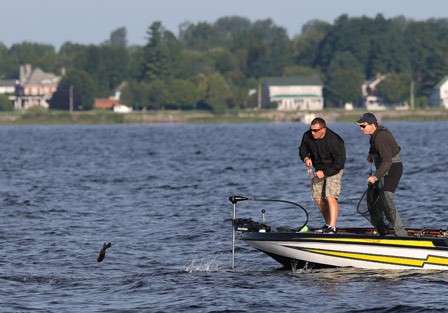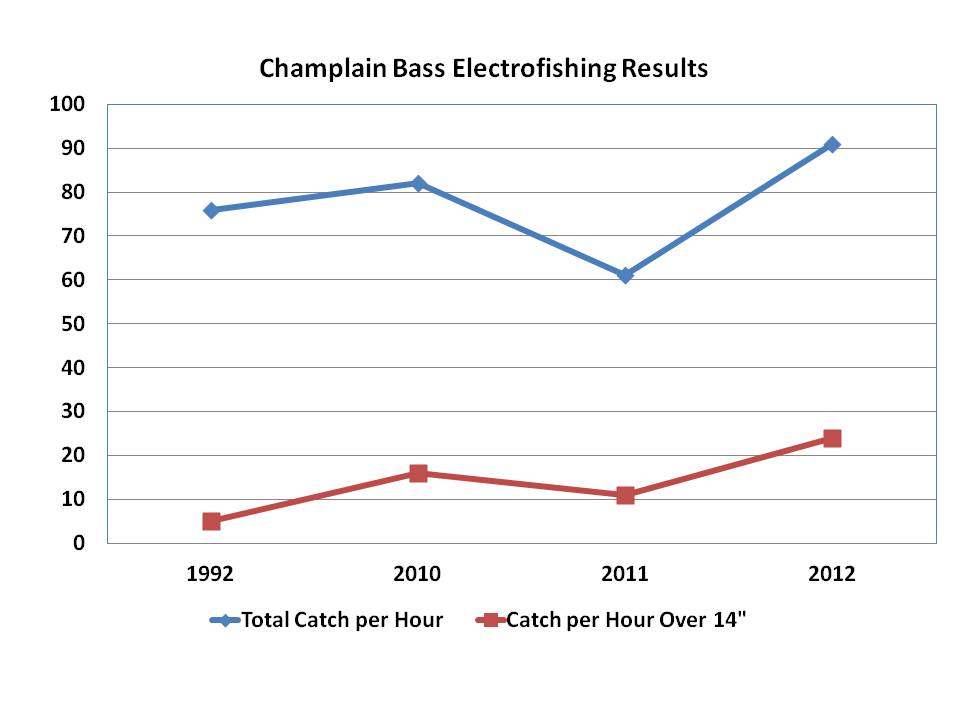
PLATTSBURGH, N.Y. — Early this year when the schedules for major fishing organizations were released, residents around Lake Champlain expressed concern about the impact of bass tournaments on their lake. Vermont and New York fisheries officials contacted Gene Gilliland, B.A.S.S. conservation director, for assistance in providing information to local anglers.
More specifically, residents were asking about fish displacement during the Bass Pro Shops Bassmaster Northern Open presented by Allstate, July 31 to Aug. 2. The concern of many local anglers was the impact of moving fish from the southern parts of the lake, 70 miles north to Plattsburgh, N.Y., where most major tournaments (including B.A.S.S. events) hold their weigh-ins and fish release.
Gilliland had conducted research on this subject when he was a biologist with the Oklahoma Wildlife Department. “We know the fish don’t swim 70 miles to go back home,” Gilliland acknowledged.
“But more to the point here, the Lake Champlain Research Institute at SUNY Plattsburgh recently completed a study and released a report, ‘Post Tournament Release Movements of Black Bass in Lake Champlain.’ This study confirmed that released bass are unlikely to return long distances to capture sites after release and tend to remain within 2 to 5 miles of the release site for several months.
“With repeated releases of fish in an area, the density of fish gets to a point where the fish naturally start to spread out, searching for a place with suitable habitat and foraging opportunities (food) that they can call home,” added Gilliland.
Surveys of Champlain tournament anglers indicated that 60 percent of largemouth bass weighed in were caught in mid- and northern portions of the lake. But that means 40 percent were caught south. So what does that mean for fishermen who consider South Lake their home waters and who don’t want “their” bass moved north?
“Any void created by removing bass from a particular area is filled very quickly,” said Gilliland. “In highly productive waters like Champlain, nature replenishes those stocks. Smaller fish grow up to replace the ones that are harvested or have been removed.”
To that point, the Vermont Fish and Wildlife Department began a monitoring program for black bass in 2010 and provided Bassmaster.com with electrofishing data showing that the fishery is quite strong. Biologist Shawn Good’s surveys compared results from 1992 with data collected from 2010 through 2012. Although no data was collected in 2013 because of exceptionally low lake levels and 2014 data had not been analyzed at this writing, Good noted that this is a long-term program and that reports on the population trends will continually be updated and provided to the public.
See more data and a Q&A on the next page.
Good’s results show that despite increased tournament activity, the largemouth bass population in Champlain is improving, showing an almost 20 percent increase in overall abundance since the 1992 survey. And the numbers of quality-size fish in the population has increased a whopping 380 percent in that same 20-year time span (see chart below).

“Anglers have asked these same questions for 25 years,” Gilliland added, “and study after study has produced the same answers: Yes, fish get redistributed and populations show ups and downs. But bass are a very resilient species and populations that are temporarily altered by tournaments return to equilibrium with the lake’s carrying capacity very quickly.”
Rather than look at one year’s lows or highs, Gilliland and Good both agreed that long-term trends are what really matter, and the trend at Champlain is going in the right direction.
In response to questions from Bassmaster.com, Gilliland offered the following answers about B.A.S.S. fish care protocols and the fate of released fish in general.
Q: What happens to the fish after the weigh-in?
A: B.A.S.S. pioneered the concept of the live-release bass tournament more than 40 years ago. Following the weigh-in, all live bass are returned to the lake from which they were caught.
Q: What percentage of fish are released alive?
A: A typical B.A.S.S. tournament releases upward of 90% of the bass that are brought to weigh-in. Nationwide, among all bass tournaments (professional and amateur), during all seasons, the number is upward of 75% live release.
Q: How are the bass transported back to the lake?
A: B.A.S.S. uses specially designed Shimano Live Release pontoon boats fitted with 900-gallon oxygenated holding tanks that allow tournament staff to release fish in multiple locations.
Q: Are they released in the same spots where they were caught?
A: No. Fish are brought in from all over the lake so it would be impossible to return each fish to its capture location.
Q: Where are they released?
A: The release boats take the fish safely away from high traffic areas and release them in open water where they can disperse in all directions.
Q: After the fish are released by the boat, do they go back to where they were caught?
A: A small number of the released fish may find their way “home” but most will relocate in areas within several miles of the release site where they find suitable habitat and food. Dispersal time and distance traveled varies with season and species (smallmouth bass tend to travel farther after release).
Q: What happens to the fish that die before or during the weigh-in?
A: Fish that are brought to weigh-in but not released are donated to local charities or law enforcement agencies. They are not wasted.
Q: What is the penalty for weighing in a dead fish?
A: B.A.S.S. rules require a 1/4-pound (4-ounce) penalty for weighing a dead bass. This is a strong incentive for anglers to keep their catch alive and healthy.
Q: Are the anglers allowed to cull fish that are dead?
A: No. B.A.S.S. rules strictly prohibit releasing a dead bass as do most state fish and game laws. If a fish dies while in the angler’s care, that fish becomes part of the daily limit and cannot be replaced with another fish.
Q: What steps does B.A.S.S. take to ensure the health of bass that are going to be released?
A: Two part answer…First, anglers care for their catch in the boat. This involves proper use of their livewell aeration systems to maintain good water quality throughout the day, maximizing oxygen levels and regulating water temperatures. Second, the B.A.S.S. weigh-in process is streamlined and efficient to minimize the time fish are out of the water, getting them weighed and on to the release boat as quickly as possible. B.A.S.S. recommends anglers and tournament organizers follow the protocols described in the B.A.S.S. publication Keeping Bass Alive, found online at www.bassmaster.com/conservation.
